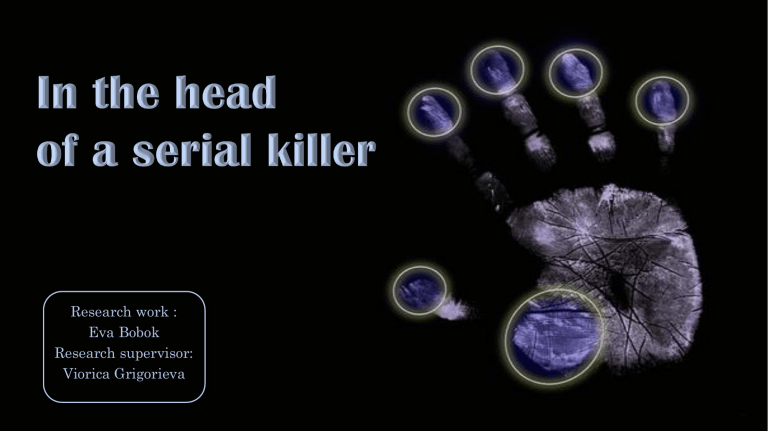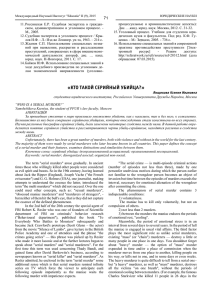
Research work : Eva Bobok Research supervisor: Viorica Grigorieva Forensic psychiatry - is a complex branch of knowledge at the intersection of legal sciences and the medical science of psychiatry. It studies the features of a person's mental activity disorder during the commission of actions or omissions, the consequences of which are of legal significance. About twenty percent of the prisoners are psychopaths. Before the age of forty, they commit an average of four violent crimes. Eighty percent become repeat offenders in the next three years after their release. Scientists and forensic psychiatrists are trying to figure out how their brains differ from normal and what turns a person into a serial killer. American neurologist James Fallon has been studying the brains of the most violent psychopaths and murderers using MRI for decades. He notes that, unlike healthy people, psychopaths have less active orbitofrontal cortex-areas in the gray matter directly above the eye arches that are responsible for social skills, learning ethics, morality, decision-making, and control of impulsivity and aggression. But that doesn't make a person a serial killer. The decisive factor - is mental trauma, violence experienced in childhood and organic changes in the brain «When I was about fifteen years old, God revealed himself to me in a visible image and his voice and ordered me to perform orthopedic experiments for the purpose of self-healing and saving humanity. It was a time when I had strange ideas: my parents put a lock on their bedroom door, and in the corner, near the door, leaned a stick.» John. Challenger "I kept hearing her talking to me. And she ordered me to do all sorts of things. And I couldn't do them. And there was a guy who told me not to do what other people told me to do. And that put me in the hospital for not doing what they told me to do." G. Lee Lukas A Charismatic Killer Theodore Robert (Ted) Bundy - is an American serial killer, rapist, kidnapper, and necrophile active in the 1970s. Its victims were young girls and girls. The exact number of his victims is unknown. The educated, attractive lawyer didn't look like a sadistic rapist. Bundy was able to charm: with this skill he used to find victims. Thanks to this quality, he "won" the nickname "Charismatic killer". He was not able to lead a normal life, although Now, if Bundy was on the street and noticed a pretty outwardly he seemed to be able to cope with any life young woman, he followed her. The criminal tried situation. Bundy could feel the ominous gloom rolling many times to get rid of the obsession, continuing his over him. If he felt that he was beginning to be drawn way along the street, after the woman he noticed to a crime, he tried to force himself to stay at home, disappeared behind the doors of the house. But it so as to avoid meeting women who might get in his didn't always work out . way. However, this was becoming increasingly difficult. And a few weeks later, the victim's body was found in a shallow pit… "Hillside Stranglers" or "hill Stranglers" is the nickname given by the media to serial killers Kenneth Bianchi and Angelo Buono. Using police uniforms, they abducted, raped and killed girls and women between the ages of 14 and 28 Kenneth Bianchi's foster mother forced the child to hold his hand over the gas burner until the burn appeared, saying that she was doing it for his own good, and forcing him to swear his love, despite the pain and torment that her son endures from her. Based in Los Angeles, Bianchi as Steve, along with his native uncle, Angelo Buono, formed a pair of killers. They combed the streets for women, raped, strangled, and dumped the bodies on the hillsides around the city. Bianchi was examined by a psychiatrist only during the judicial procedure. When a conclusion was required about the possibility of his participation in the trial, under hypnosis, Steve "went outside" and began to tell monstrous stories about Kenneth's mother, uncle Angelo and women buried in the suburbs of Los Angeles. • All serial killers report feelings that they could not control, voices that prompted them to commit criminal acts, feelings of an unknown force somewhere in the depths of their soul, it seemed to them that these forces took over their body, making it their hostage. • These individuals attacked people, raped women, and reached orgasm only when the victim lay in front of them in a completely helpless state. They committed murders, mutilated and dismembered bodies to hide the traces of the crime and avoid arrest. • The more violent the crime, the more acutely they themselves felt the cruelty, until the moment came when the crime itself was no longer enough to completely erase the disgust, the self-loathing. Where do these voices and feelings come from? Bobby Joe long's severely crippled brain, which had suffered a series of traumatic brain injuries, no longer had an effective regulator that could control the flow of feelings, as a result of which he was unable to suppress the rage and cruelty-they were associated with sex and power over the victim. Gary Schaefer's mind was already in turmoil over his stepdaughter's rejection as he drove past his victims The psychological reaction that triggers the delusional-dream mechanism may be triggered by an event that occurred in the real world! Ted Bundy went berserk at the sight of a pretty classmate who aroused sexual aggression in him. However, he was rejected by just such a woman. John Gacy was driven by the desire to destroy some active wormhole that he felt inside himself. With the ritual of killing young people, he reproduced a nightmare in which his own father killed the boy John Gacy for his own weakness and apparent lack of courage. A thorough study of the stories of serial killers who became the object of our research shows: the fact that the society referred to criminal behavior, was in fact a protection mechanism that has faced the individual. And this combination of psychological disintegration with organic brain damage, in all cases, leads to the appearance of an individual who is beyond our traditional ideas of insanity. "Psychopaths. A true story about people without pity, without conscience, without remorse" - Kent A. Keel "Lucifer effect. Why good people turn into villains " Philip Zimbardo "Guide to forensic psychiatry" - Andrey Tkachenko "In the soul of a psychopath. Journey to the world without pity, conscience and feelings " - Peter Gannushkin







